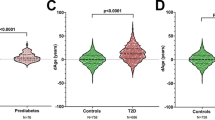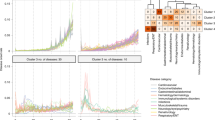Abstract
Age is an important factor when considering phenotypic changes in health and disease. Currently, the use of age information in medicine is somewhat simplistic, with ages commonly being grouped into a small number of crude ranges reflecting the major stages of development and aging, such as childhood or adolescence. Here, we investigate the possibility of redefining age groups using the recently developed Age-Phenome Knowledge-base (APK) that holds over 35,000 literature-derived entries describing relationships between age and phenotype. Clustering of APK data suggests 13 new, partially overlapping, age groups. The diseases that define these groups suggest that the proposed divisions are biologically meaningful. We further show that the number of different age ranges that should be considered depends on the type of disease being evaluated. This finding was further strengthened by similar results obtained from clinical blood measurement data. The grouping of diseases that share a similar pattern of disease-related reports directly mirrors, in some cases, medical knowledge of disease–age relationships. In other cases, our results may be used to generate new and reasonable hypotheses regarding links between diseases.




Similar content being viewed by others
References
Ben-Dor A, Shamir R, Yakhini Z (1999) Clustering gene expression patterns. J Comput Biol 6(3–4):281–297
Blei DM, Ng AY, Jordan MI (2003) Latent Dirichlet allocation. J Mach Learn Res 3:993–1022
Carol K, Sigelman EAR (2005) Life-span human development. 6. Wadsworth Publishing, 3–4
Chandra RK (1984) Parasitic infection, nutrition, and immune response. Fed Proc 43(2):251–255
Cnattingius S, Hultman CM, Dahl M, Sparen P (1999) Very preterm birth, birth trauma, and the risk of anorexia nervosa among girls. Arch Gen Psychiatry 56(7):634–638
DeLamater J, Friedrich WN (2002) Human sexual development. J Sex Res 39(1):10–14
Diamond SG, Markham CH, Hoehn MM, McDowell FH, Muenter MD (1989) Effect of age at onset on progression and mortality in Parkinson’s disease. Neurology 39(9):1187–1190
Dunson DB, Baird DD, Colombo B (2004) Increased infertility with age in men and women. Obstet Gynecol 103(1):51–56
Ekeus C, Lindberg L, Lindblad F, Hjern A (2006) Birth outcomes and pregnancy complications in women with a history of anorexia nervosa. Bjog 113(8):925–929
Fliss A, Ragolsky M, Rubin E (2008) Reverse translational bioinformatics: a bioinformatics assay of age, gender and clinical biomarkers. AMIA summit on translation bioinformatics San Francisco, CA
Foxman B, Barlow R, D’Arcy H, Gillespie B, Sobel JD (2000) Candida vaginitis: self-reported incidence and associated costs. Sex Transm Dis 27(4):230–235
Geifman N, Rubin E (2011) Towards an age-phenome knowledge-base. BMC Bioinforma 12:229
Geifman N, Rubin E (2012) The age-phenome database. SpringerPlus 1(4)
Giedd JN, Blumenthal J, Jeffries NO, Castellanos FX, Liu H, Zijdenbos A, Paus T, Evans AC, Rapoport JL (1999) Brain development during childhood and adolescence: a longitudinal MRI study. Nat Neurosci 2(10):861–863
Hartigan JA, Wong MA (1979) A K-means clustering algorithm. Appl Stat 28:100–108
Hasenclever D, Diehl V (1998) A prognostic score for advanced Hodgkin’s disease. International prognostic factors project on advanced hodgkin’s disease. N Engl J Med 339(21):1506–1514
Ho JH (1978) An epidemiologic and clinical study of nasopharyngeal carcinoma. Int J Radiat Oncol Biol Phys 4(3–4):182–198
Johnson SC (1967) Hierarchical clustering schemes. Psychometrika 32(3):241–254
MALLET: A Machine Learning for Language Toolkit [http://mallet.cs.umass.edu]
Mueller N (1991) The epidemiology of HTLV-I infection. Cancer Causes Control 2(1):37–52
Samartín S, Chandra RK (2001) Obesity, overnutrition and the immune system. Nutr Res 21(1–2):243–262
Sharan R, Maron-Katz A, Shamir R (2003) CLICK and EXPANDER: a system for clustering and visualizing gene expression data. Bioinformatics 19(14):1787–1799
Sherlock G (2001) Analysis of large-scale gene expression data. Brief Bioinform 2(4):350–362
Su JM, Li Y, Ye XW, Wu ZF (2007) Oral findings of hypophosphatemic vitamin D-resistant rickets: report of two cases. Chin Med J (Engl) 120(16):1468–1470
Suzuki R, Shimodaira H (2006) Pvclust: an R package for assessing the uncertainty in hierarchical clustering. Bioinformatics 22(12):1540–1542
Syrjanen K, Vayrynen M, Castren O, Yliskoski M, Mantyjarvi R, Pyrhonen S, Saarikoski S (1984) Sexual behaviour of women with human papillomavirus (HPV) lesions of the uterine cervix. Br J Vener Dis 60(4):243–248
Vecht CJ (1993) Effect of age on treatment decisions in low-grade glioma. J Neurol Neurosurg Psychiatry 56(12):1259–1264
Wallach HM, McCallum DMA (2009) Rethinking LDA: Why Priors Matter. NIPS
Weinstock H, Berman S, Cates W Jr (2004) Sexually transmitted diseases among American youth: incidence and prevalence estimates, 2000. Perspect Sex Reprod Health 36(1):6–10
Yin L, Huang CH, Ni J (2006) Clustering of gene expression data: performance and similarity analysis. BMC Bioinforma 7(Suppl 4):S19
Acknowledgements
This project was funded by The National Institute for Biotechnology in the Negev.
Author information
Authors and Affiliations
Corresponding author
Additional information
All supplementary material is available at: http://rubinlab.med.ad.bgu.ac.il/APK/APK_clustering_supplementary.html (URL appears in the manuscript under Methods - availability).
About this article
Cite this article
Geifman, N., Cohen, R. & Rubin, E. Redefining meaningful age groups in the context of disease. AGE 35, 2357–2366 (2013). https://doi.org/10.1007/s11357-013-9510-6
Received:
Accepted:
Published:
Issue Date:
DOI: https://doi.org/10.1007/s11357-013-9510-6




